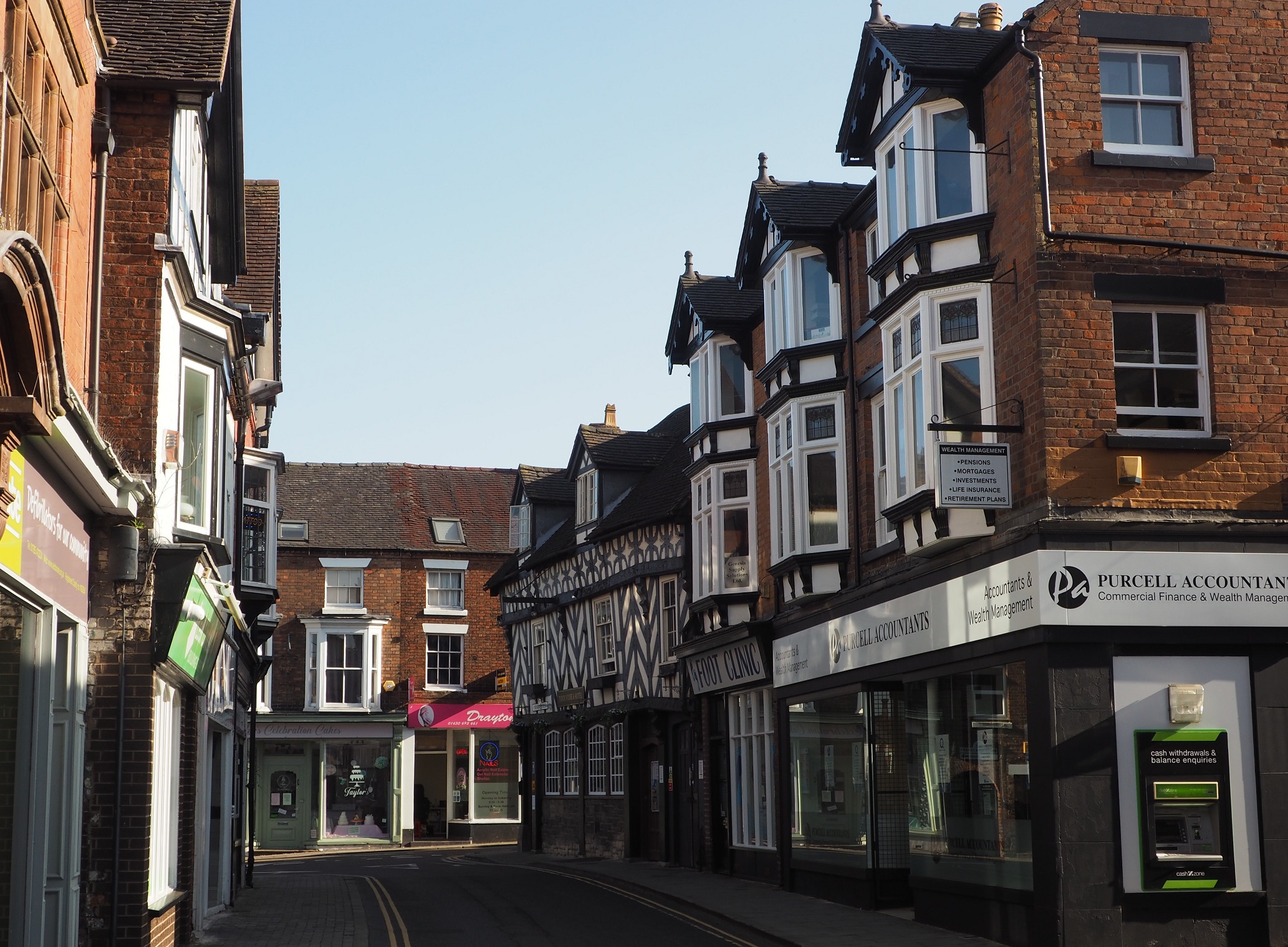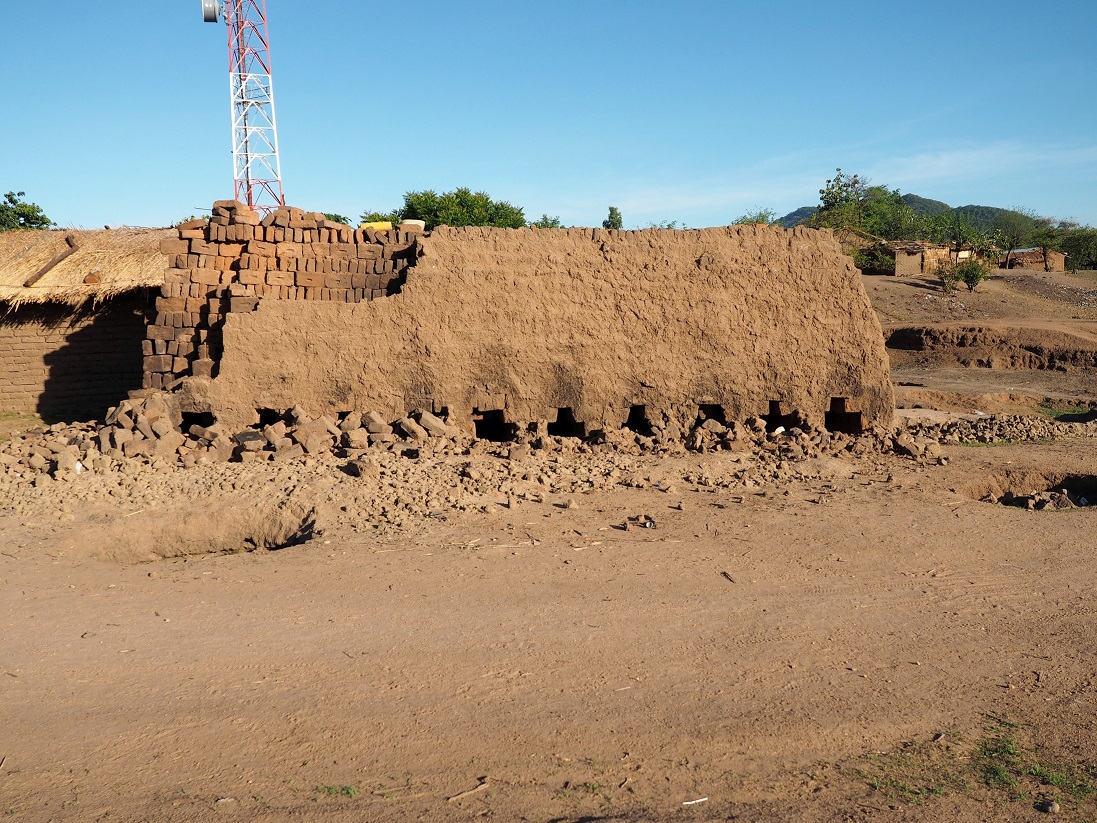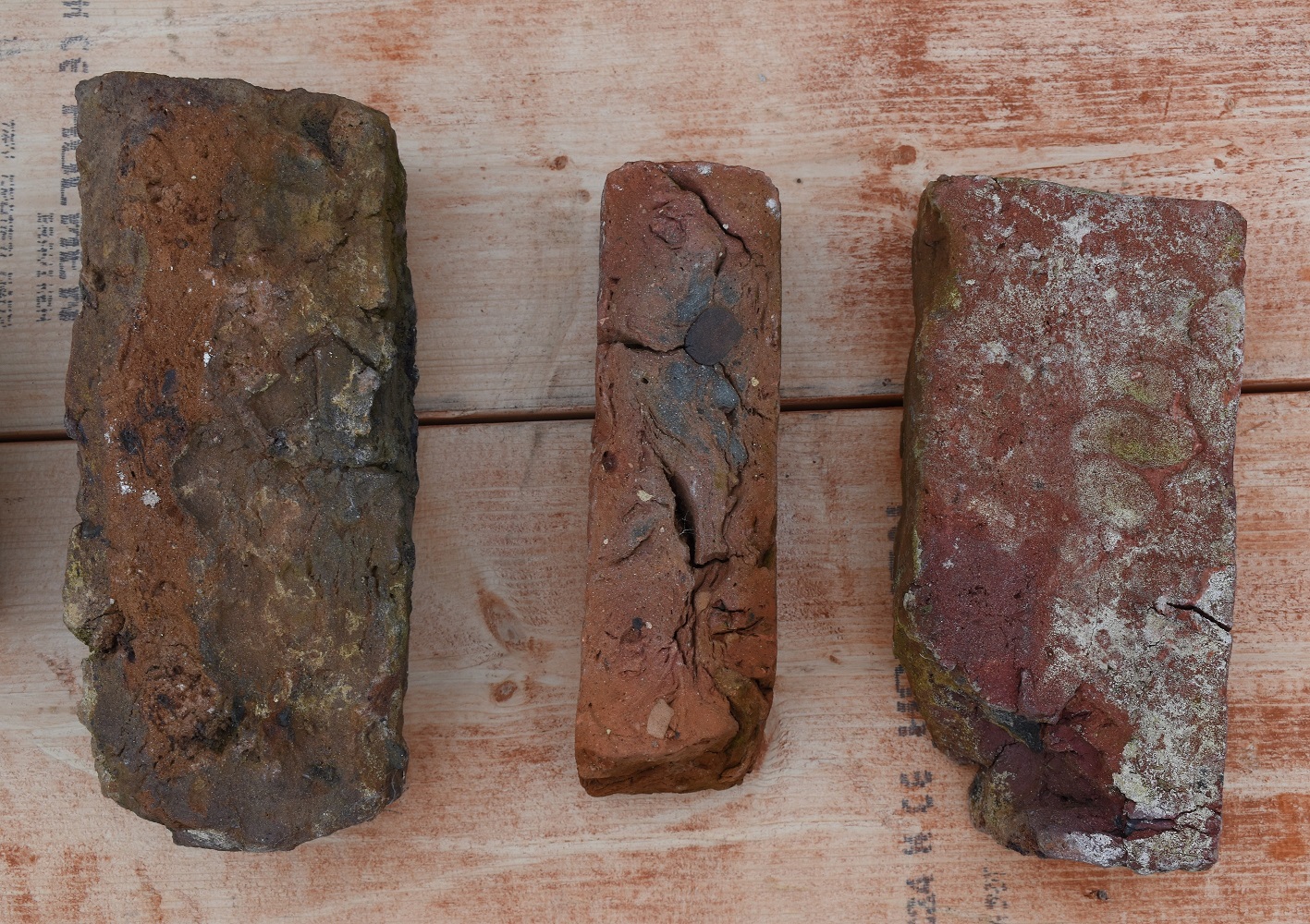Traditional Brickwork
Inherent defects, vulnerabilities and the importance of good maintenance
Terrence Lee

Brickwork from the 18th to the 20th century in Market Drayton, Shropshire (All photos: Jonathan Taylor)
Traditional bricks may be regarded by some as hard wearing and impervious, universally usable in each and any brickwork application. However, the very title 'traditional' suggests a process of both manufacture and construction passed down through scores of generations of brickmakers and bricklayers who executed their crafts in a time-honoured way. It implies a technology developed in an age when transport options were lamentable or non-existent and always costly, and building materials were almost always sourced locally.
In the case of brick this means local clays fired in clamps or kilns using the fuels available, as close to the construction as possible. In considering the causes of brickwork failure, while structural problems are one factor, the materials and technology used to make the bricks and mortar themselves are another.
Wide variations in physical form and quality of older bricks are common as a result of their unscientific and inconsistent manufacture across a myriad of small brickmakers which sprang up wherever there was a clay deposit. These anatomical variations and faults in the mortar in which the brick is laid may not be individually significant, but together they can make brickwork more vulnerable to external factors and accelerate decay.
| Traditional kiln and clamp-fired bricks from 17th and 18th century buildings in Shropshire. This blackened brick probably lined a fire channel and should be highly vitrifed. |
Anatomy of Traditional Brick
For bricks to be durable and have the required form for use in construction, the clay with which they are made should contain a number of naturally occurring minerals which influence the chemical reaction of the brick clay during firing and ultimately, the finished product.
Traditionally, brickmakers could not alter the mineral balance of the clay but they could add elements such as sand, lime and ash. An imbalance of elements may result in the brick being more prone to the effects of external decay factors.
Clays consist mainly of a few specific minerals which have a plate-like structure and tend to form sheets. These clay minerals, which are responsible for the materials unique properties, formed over millions of years from the weathering of rocks and volcanic ash deposits, and there are wide variations in their minerology from region to region.
Because they were so accessible, clays found just below topsoil level are known as brick earths. These were the only clays used for brick-making until the Elizabethan era and their use continued well into the 19th century, despite being the most variable.
As well as the clay minerals, most brick clays will also contain a variety of other materials which affect how the clay responds to the firing process in the kiln and, ultimately, the performance of the brick. These include sand (silica), alumina, magnesia, sodium, potassium, iron as well as lime and potash.
For example, small quantities of iron when it oxidises during firing produces hematite (from the Greek for blood) which influences the colour of the finished brick. If iron is present in the form of pyrites however, this can expand when it comes in to contact with moisture and oxygen, causing splits and fissures. Both lime and potash were commonly used as a flux, a material that enables particles in the clay to start to fuse permanently together at lower firing temperatures.
Some degree of fusion is essential for the cohesion of the fired brick, but too much flux can lead to full vitrification, in which part of the clay actually melts and the brick slumps. Alumina can also result in misshapen bricks for the same reasons, but it is added to improve the plasticity of the clay before firing. Silica, on the other hand, is essential for toughness, but too much can cause brittleness.
Larger pieces of stone or flint which were not found and removed during the manufacturing process are known as inclusions. These may react differently under high temperatures and can rupture both during and after firing, causing fissures, tears and bulging in the brick, or they may protrude through the fire skin of the brick, weakening it and rendering it unusable as a facing. Limestone inclusions, for example, turn to quicklime when fired, so when the bricks get wet, the inclusions slake, rupturing and splitting the brick.
Problems Incurred During Firing

A brick clamp in Malawi: the bricks lining the fire channels at the bottom could be well fired or over-fired,
while those on the outside and furthest from the heat will be little more than dried clay.
For centuries the firing of bricks was a largely uncontrollable process in which temperatures varied significantly within the clamp, essentially a large stack of unburned bricks laced with combustible material such as furze or hedge cuttings.
The bricks were fired at between 900 and 11000C, with temperature variation effecting both the colour and the quality of the brick. Those closest to the fire channels were burnt blue grey, while those on the outer edges of the kiln were often underfired and pink in colour.
As well as a wide variation of colours found within one firing, rapid increases in temperature could result in weak bricks with a blackened core.
Vitrification often occurred in wood fired clamps where bricks were near the fuel source, depending on the mineral composition of the clay. Nevertheless, most bricks would be usable somewhere in a building, the majority hidden from view and covered by layers of plaster.
Vulnerability of Traditional Brick
Poor materials and inconsistent firing can usually be identified by sporadic examples of eroded bricks on an otherwise sound elevation, and it is rare to find large expanses of inadequate material. Furthermore, even with a variety of defects and visual anomalies, brickwork can usually deal with environmental conditions and rainfall successfully, if laid in an effective lime mortar. Indeed, any surviving pre 19th century masonry has already been proved to be perfectly adequate, and with proper care it should last another 200 years. Conversely, the symptoms of an imbalance of minerals and other materials in the brick clay outlined above can both facilitate and be compounded by other external factors including water ingress and modern inappropriate intervention.
External Forms of Water Ingress
Quite apart from natural erosion of joints which can allow water ingress from windblown rain, the continuous presence of high levels of moisture both on the surface and inside the wall will undo the properties of the lime mortar. Frost action in particular will make the mortar friable and soil like, and an attractive environment for both plant and insect life, in effect, returning the joints to nature. Hollow and crumbling mortar joints can provide a gateway for moisture to enter a wall, particularly if rainwater is channelled or directed by broken or damaged architectural features such as cornices or banding courses on to adjacent brickwork.
Forms of water ingress can often be attributed to maintenance issues and neglect. Quite apart from damaged chimneys and roof elements, sources might include cracked or broken guttering and rainwater goods, damaged salt glazed drainage close to walls and below ground, or standing water on concrete adjacent to brickwork. Other forms of directed water could be from hard cement pointed elevations, panels or even individual bricks which act like a ledge, channelling rainwater quickly on to adjacent lime pointed work and accelerating the rate of decay.
Brickwork is at risk when areas of brickwork become saturated after prolonged rainfall, filling the pores, fissures and voids with water, causing spalling (flaking) of the brick faces when the moisture freezes. Salt crystallisation is one of the most common causes of brick decay. Harmful soluble salts such sulphates and chlorides can exist naturally in the brick clay, or they may come from additives found in cement mortars, from contaminated aggregates, from road salt, sea water or standing water, or they could be the result of salts leaching from high soil levels at the base of outside walls.
Original fuel ash-based mortars, although cheap and highly pozzolanic, may contain harmful substances associated with coal burning including sulphates in particular. In their benign form, these salts may appear as efflorescence as a white powder on the face of the brickwork which can be brushed off relatively easily. A far more serious form of sulphate attack occurs when the salts crystallise inside the brick, causing the surface to spall under the pressure. Sulphate attack, perhaps one of the worst forms of decay, can affect individual bricks, panels, or even entire elevations of brickwork.
Cementitious Pointing
The use of hard cement pointing mortars compounds the problems of water ingress discussed above by trapping moisture inside the walls. Since the lime mortar joints form the main conduit for water evaporation from the wall, and as this can be up to 20 per cent of a wall surface cement pointing greatly increases the risk of the bricks becoming saturated. Hard cement pointing also forms ledges inside the brickwork joints which allow water to accumulate until it subsequently freezes, causing the edges of bricks, or arises, to break, resulting in the widening of brickwork joints.
Maintenance
Regular maintenance can avoid the costs of much larger repair work, the aim being to identify a problem and carry out remediation before it can become worse. Ideally, a maintenance check should be carried out at least twice a year, one of those times being after the leaves have fallen in late autumn. In fact, paying attention to the brickwork on a much more regular basis can only be a good thing and is likely to increase the awareness of the things that look out of place.
The maintenance check should involve a thorough examination of the brickwork, working systematically from the chimneys down to the base of the walls, and can require access equipment such as cherry pickers, ladders as well as contractual help in order that the checks and any work required can be done safely. Working alone on a maintenance check where heights and confined spaces are involved has potential hazards and should be avoided. In all cases it is important to inform others that a maintenance check is under way.
Priority should be to external factors that are affecting the brickwork before focusing on the brickwork itself, as there is no point carrying out pointing repairs for example, if gutters, broken down pipes, blocked drains and gullies are still directing water on to the walls. Other factors to take note of are the condition of brickwork where there are hard concrete or paved adjacent surfaces where persistent rain splashing can cause accelerated decay or where external flower beds are raised too high against the brickwork.
Chimneys are often out of sight and out of mind, yet these are a potential artery of damp into the heart of the building. Problems here can be as simple as having no cowls on pots, but are often related to cracking of the flaunching on top and decades of erosion of the chimney stack brickwork due to the use of cementitious mortars, and from damaged lead flashings.
Coal fires are another source of sulphates, and as salts accumulate on the side where evaporation occurs the most, brickwork may expand on this side causing the chimney itself to curve. It is worth noting that any work required on a chimney cannot be accurately evaluated without close inspection and while a drone can be a useful tool, it is by no means fool-proof.
Recording the findings of a maintenance check with a comprehensive set of photographs and site notes is important because it is easy to miss areas of concern, particularly on larger and more complex buildings. Careful planning will ensure you make full use of any equipment and help that has been hired, and it is a good idea to use pre-prepared brickwork maintenance sheets which break down the building into elevations, each with their features detailed.
Good Practice in Maintenance Repair
Brickwork repairs to this Georgian farmhouse include localised replacements, pointing with a mortar to match the existing lime-rich mortar, and the replacement of the gauged brick arch seen here on the right, which has been rubbed up ready for the joints to be picked out.
Works resulting from a maintenance check should be approached like any brickwork conservation project, doing only work that is necessary, retaining original materials wherever possible, and with all aspects considered carefully, including brick and mortar matching, no matter how minor the work may be.
Once a list of maintenance issues has been drawn up, the work required should be prioritised and categorised according to skill requirements (to identify those elements requiring non-brickwork skills such as fixing gutters, and those that require brickwork conservation skills, for example).
The work can then be planned. Maintenance repairs should be prioritised so that architectural features which are intended to protect brickwork are repaired first. Mortars should always be softer than the bricks to be pointed and building limes selected should reflect not only the era of the brickwork but potentially the degree of exposure it is subjected to.
It is a good idea to keep a supply of traditionally made bricks to match the existing ones in size, texture and colour. Brickmakers can and do run out of stock of certain bricks for which there is high demand within conservation circles, so it is worth planning for sporadic repair requirements in advance.
Inserting hard bricks randomly selected from a reclamation yard is not a suitable alternative because they can accelerate decay on adjacent brickwork by acting like a water shed or causing water to flow around them on to the softer surrounding brickwork, rather like inserting a piece of granite into a soft sandstone wall.
Equally, avoid using bricks whose provenance is not known. Bricks infused with soot deposits or salts for example can affect adjacent brickwork, or if they were intended for internal work, they simply might not be up to the job. Mortars can be prepared at least 24 hours in advance, in fact the longer the better when putty mortars are concerned.
When carrying out minor pointing works, jointing would usually be blended in with the surrounding finish by a skilled bricklayer, but where the existing is deemed inappropriate and there is no trace of the original profile, a modern conservation finish may be used with the joint dressed slightly back from the edges of the bricks.
Protecting even the smallest repair is important so that the repair is durable and that it does not have to be redone. Bleaching and rapid drying of joints are common problems and lime bloom on brickwork another. Wet pads of hessian or similar can be fastened over even the smallest areas of pointing to help the lime mortar joints cure slowly in this formative stage.
When maintenance work has been completed, it is useful to keep a record of what has been done. This can be either in the form of contractor invoices, materials or simply a handwritten check sheet noting the elevation and what has been carried out. In this way, if something does go wrong you can learn from any mistakes. As is obvious from the thousands of Georgian brick buildings found across the country, well maintained brickwork is quite capable of surviving 250 years, despite the idiosyncrasies of the materials and manufacturing processes. If well repaired and maintained they will, no doubt, be here in another 250.




